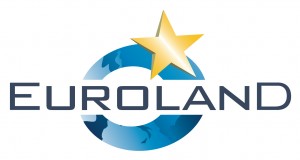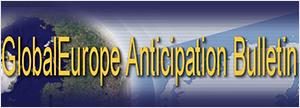{Three new criteria to take in account for allocating institutions to a city/region. Euroring 1 area will become a vast European metropolis energized by high-speed trains (Thalys and EuroStar), fast and cheap planes and new information technologies. Meanwhile the growing complexity of the EU system (both in terms of political legitimacy as well as in terms of efficiency) requires that its locations generates both democratic added-value and an increase in human resource competences. Three new criteria have therefore to be formulated in order to create an optimal allocation.}
a. A European Added-Value in terms of sectoral Leadership: to find out the cities and regions endowed with the political, symbolic and historical strength required to anchor in history and in a sustainable fashion a European Union of 500 million inhabitants (i.e. historically endowed with leadership potential on a European scale and in the sector of the concerned institution).
b. A European Added-Value in terms of Democracy : to choose among the cities and regions those offering the most significant democratic added-value (i.e. those physically and symbolically likely to bring the institutions closer to a significant amount of European citizens).
c. A European Added-Value in terms of Competences : to identify among the cities and regions those with the human resources bases most adapted to the needs of the institutions they will be hosting (the growing complexity of EU management requires the diversification of the expertise needed within the institutions as well as an increasing resort to external expertise).
The choice of Frankfurt for the European Central Bank in the 90s was a decision breaking the monopoly of Brussels-Luxemburg-Strasburg on major EU institutions and clearly in line with the above criteria. This choice had already put the EU system into a new geographical dimension, breaking away from the 50s system.
{{A first possible scenario for allocating EU institutions in EuroRing 1 region}}
The application of these three criteria to the cities and regions of the Euroring 1 area has resulted in the definition of a first possible scenario Euroring 1A, with the following distribution of EU institutions :
– London: European Council
– Brussels: European Parliament
– The Hague: European Court of Justice
– Paris : European Commission
– Frankfurt : European Central Bank
As to the other cities, the three criteria enabled to confirm the choice of Frankfurt for the Bank. The Hague and the Delta Metropolis region (also including Amsterdam, Rotterdam and Utrecht) has already been chosen on a global-scale to be the capital center of justice. Finally Paris and the Paris area, already considered in the 50s/60s as a host to the Commission, is the other global metropolis (with London), likely to ensure international visibility for the European integrated executive organization ; and to be in line with the historic role of the impulse played by the French since the origins of the European project.
{{Seven key ideas to keep in mind for elaborating tomorrow’s EU political geography}}
In order to understand the constraints affecting tomorrow’s EU power distribution and geographical organization, a few key constraints should be kept in mind.
– Enlargement to the East will not significantly affect the demographic, economic, financial and scientific balances. Thus the centre of gravity of the enlarged EU will remain in effect in the Euroring 1 area.
– The European Parliament will have to be located in one single place.
– ‘Remoteness’ of a city or a region should be measured in terms of time of travel, cost of travel and quantity of data instantly transmittable. According to these criteria, the cities and regions of Euroring 1 are clearly among the closest from any point in the European Union.
– The EU will not have a significant presence in global affairs until it will capitalize on its cities that have, since long ago, conquered a place in the planet’s political imagination.
– Very accurate problems of recruitment met by the European institutions from their three current capitals (concerning the civil servants as much as the experts) are in the rise and affect more and more the quality of the delivered services.
– Management of big international organizations (multinational companies in particular) show that for a decade already the concepts of physical meetings have been totally disrupted by the appearance of new technologies. The notion of proximity of the various functions within one organization has considerably been enlarged.
– Parliament-Government geographical proximity is only rarely a choice from the Parliament and more generally the choice of the executive power eager to keep the legislative power under strict supervision.
Far from being a XXth century system to fix, we think that European Union of the XXIst century is a new system to invent. This is at least the conviction of Newropeans in the EuroRings project.
But contrarily to the current centralistic initiative of some MEPs (who only wants to bring the Parliament to Brussels and nothing more), a democratic EU does not require more ‘Brussels centralism’ but more decentralised management. The question is not to put the Parliament in Brussels too … but rather to put everything else but the Parliament outside Brussels.
The aim should be to get the institutions closer to the citizens, not further away from them, in Brussels.This is what Newropeans proposes with the ‘EuroRings’ geographical distribution of EU institutions (see proposal N° 3 of Newropeans programme ). The EU needs a vision for the 21st century. And the institutionnal geography, where does power physically stands, is part of this vision. When some EU political forces obviously see power in one place, which means in the hands of the same clique, Newropeans sees the power distributed thorghout all Member states, close to the citizens, making the EU a possession of all its 500 millions citizens and not the ‘thing’ of a privileged group.
MEPs have a very concrete understanding of the meaning of the geographical distribution of European institutions. The current geography of EU institutions is the result of both a horse trading processes at the European Council level and the lack of adaptability of a system conceived in the 50s.
{{The dual seats of the European Parliament are damaging for democracy}}
Firstly, MEPs have to pay a high price due to travels, fatigue, loss of efficiency, cost increases and blurred visibility because of the fact that they have to move from one Parliament seat to the other, between Brussels and Strasburg. This situation is by all means damaging for democracy.
But if the Parliament is the most obvious example of the obsolescence of the geographical distribution of EU institutions inherited from the post war years, it is not the only one. Indeed the whole system has to be drastically reformed in order to meet the EU XXIst century challenges.
Changing Parliament’s location will require a complete change in the EU geography
In order to contribute to this very important debate for Europe’s future (as politics and geography are strongly interconnected), Newropeans is trying to explore possible scenarii for a new geographical distribution of EU institutions, moving towards a greater proximity to citizens, democratization and efficiency. Meanwhile the successful move of the German capital from ‘Bonn to Berlin’ showed that technical and financial problems related to the move of EU institutions should not hamper innovative thinking because of the small size of the administrations concerned.
Meanwhile MEPS who want to change the Parliament’s location should know that it is impossible to change part of the existing system without changing it all.
The results presented here have been conducted in partnership with major European cities and regions as well as top experts. The ‘EuroRings’ process (still on going), as we call it, is now coming to maturity and may fuel a wider public debate.
{{The current geographical distribution was totally rational 50 years ago}}
The rationality of the distribution of EU institutions by 2020 is indeed in perfect line with the rationality that prevailed in the 50’s for the first geographical distribution. After World War II, leaders were required to consider 2 constraints when it came to distributing the new European administrations:
a. to identify the most neutral or symbolic places that could contribute to the rapprochement of the enemies of yesterday (especially France and Germany) without provoking on the part of the various Member-States any fear that the one or the other would take control of the new common institutions
b. to choose cities and regions that would be convenient for European leaders and civil servants from 6 Member-States to meet, given the technological means available at that time (telephone, propeller planes and barely electrified trains).
From the beginning, any centralized system was strongly rejected. And that is the main common feature between the past and the future of European integration and institutional geography.
{{Technology and Economics are changing Europe’s map : the emergence of EuroRing 1}}
The internal political requirements (the need to democratize, to plant the construction in economically important cities) and the external ones (the need to build Europe’s global conurbation to compete with groupings like “Tokyo-Kyoto”, “Los Angeles-San Francisco”, “New-York-Boston-Philadelphia”, the need to assert the global role of the EU buildings with respect to cities with international influence such as Paris and London), the on-going and future technological realities (High Speed Trains, Internet), the human resources’ requirements of EU institutions (need for greater diversity and better selection), all these developments result in the need to identify one specific EU area to become the decentralized nucleus of cities to distribute the main institutions : Euro-Ring 1 = London-Paris-DeltaMetropolis (The Hague-Amsterdam-Rotterdam-Utrecht)-Rhein Gebiet (Frankfurt-Köln-Bonn)- Brussels/Antwerp.
{{Networking societies and the decentralization of power are changing Europe’s political fabric : Euroring 2 – the network of European capital cities}}
European society’s growing trend towards decentralization and increased networking bolsters the need to build upon the concept of « networks of capital cities » to organize the EU institutions of tomorrow; and it enables the identification of a second Euro-Ring : EuroRing 2, comprising all of the capital cities of other EU member-states (Dublin, Copenhagen, Stockholm, Helsinki, Vilnius, Riga, Tallin, Warsaw, Prague, Bratislava, Budapest, Bucharest, Sofia, Athens, Ljubljana, Rome, Madrid and Lisbon), to host the other institutions with operating-requirements compatible with longer commuting times.
Citizens, in most EU member-states tend to look at their capital city as the place where political power is historically located. This provides a huge added-value if properly used for an EU system which is longing for democratic legitimacy.
Meanwhile it helps to prevent the growing fear by national elites that they will never get any ounce of power back, as soon as it is transferred to the European level. The existing process allocating European Union agencies to cities through horse-trading negotiations resulted in a geogrpay opposite to what was wanted. Thes is no democratic added-value as nobody knows or understands why each agency is located in one place or another. As a matter of fact the usual allocation system does not work anymore as the Council has now for years been unable to choose where to put all agencies waiting for a seat.
(c) [Newropeans-Magazine->http://www.newropeans-magazine.org/index.php?option=com_content&task=view&id=1175&Itemid=84]


 LEAP2040 Toutes les informations et archives Europe2040
LEAP2040 Toutes les informations et archives Europe2040


